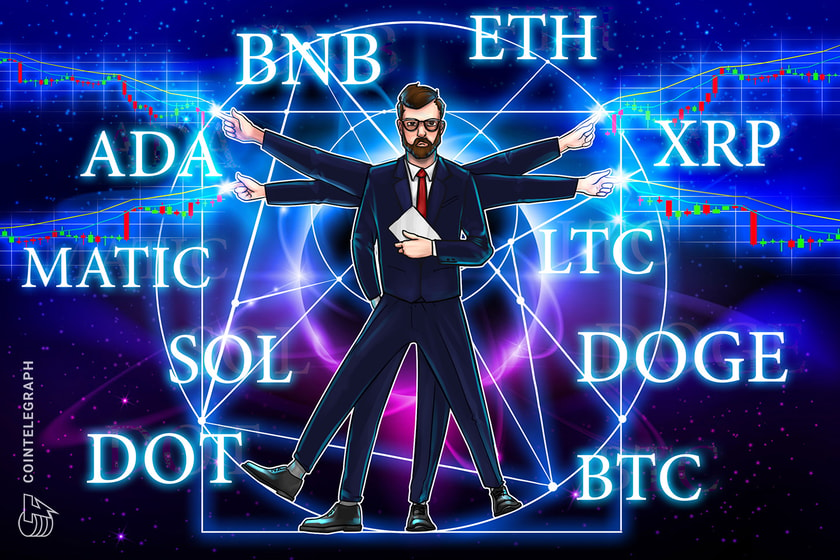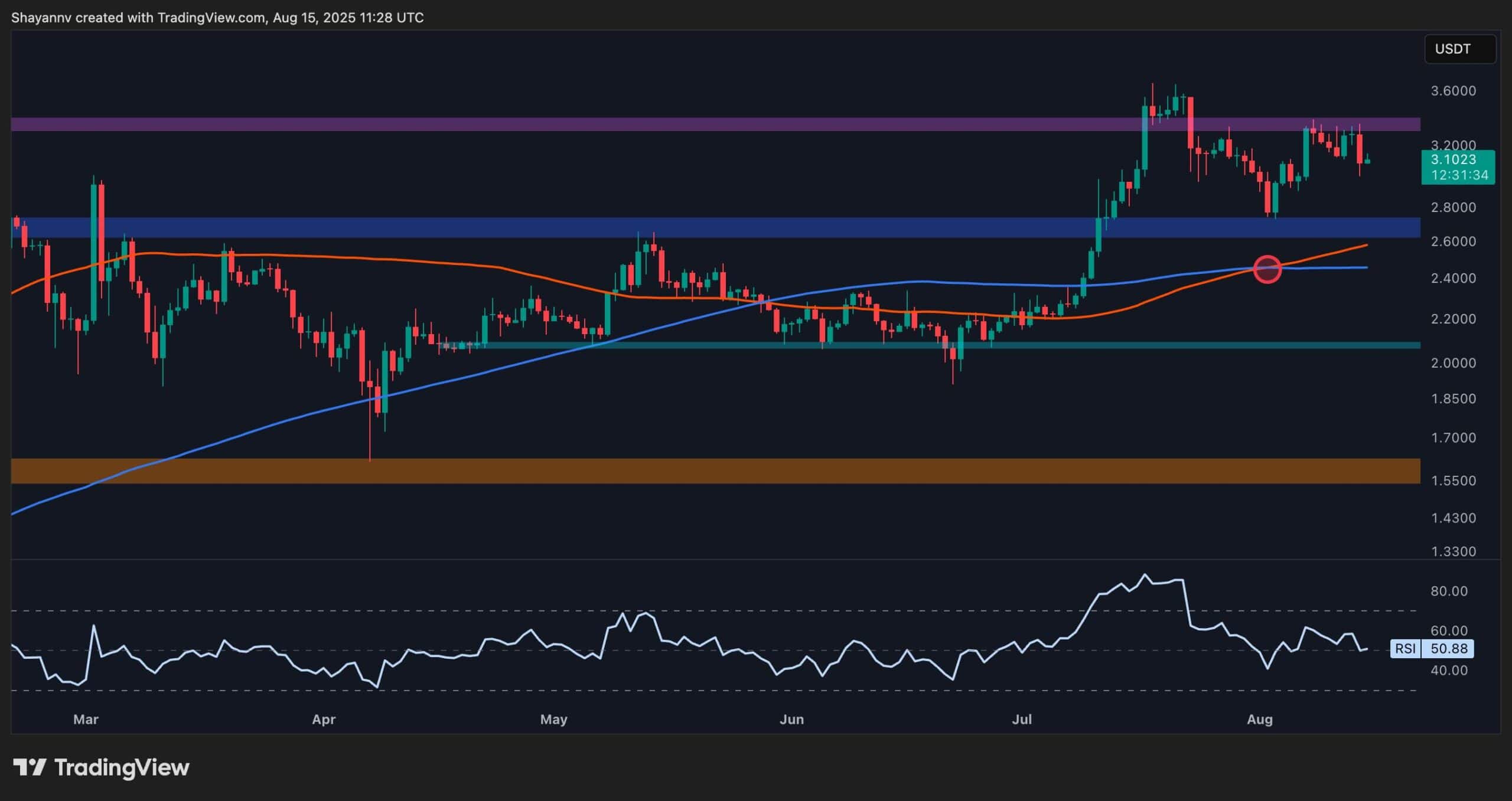Cryptocurrency
Price analysis 7/7: BTC, ETH, BNB, XRP, ADA, DOGE, SOL, LTC, MATIC, DOT

Bitcoin is still struggling to stay above $31,000.
While a tight consolidation near the overhead resistance is a positive sign, the failure to rise above it may result in short-term liquidations. However, a shallow pullback should not be considered a trend change because, many times, the bulls take a step back to regroup and launch another attack at the resistance. If the barrier is overcome, the positive momentum picks up.
Binance CEO Changpeng “CZ” Zhao said in an “ask me anything” session on Twitter that Bitcoin (BTC) could witness a bull year after its halving in 2024. CZ added that BlackRock’s foray into cryptocurrencies will be “hugely beneficial” for the industry.

BlackRock CEO Larry Fink made positive comments about Bitcoin while speaking in an interview with Fox Business on July 5. Fink said that Bitcoin was an “international asset not based on any one currency,” and investors could use it as a hedge against inflation or currency devaluation.
Could positive comments from Fink act as a floor during pullbacks? What are the important overhead resistance levels in Bitcoin and altcoins that need to be crossed to signal the start of a short-term up move? Let’s study the charts of the top 10 cryptocurrencies to find out.
Bitcoin price analysis
Bitcoin once again rose above $31,000 on July 6, but the rally was met with strong selling pressure from the bears. That pulled the price down to the 20-day exponential moving average (EMA) at $29,763.

A positive sign in favor of the bulls is that the BTC/USDT pair has rebounded off the 20-day EMA. This suggests a positive sentiment where traders are viewing minor dips as a buying opportunity. That enhances the prospects of a rally above the $31,000 to $31,500 resistance zone.
If that happens, the pair could start an upward march to $40,000. The bears will attempt to stall the up move at $32,400, but the buyers are expected to bulldoze their way through.
Conversely, if the price turns down and breaks below the 20-day EMA, it will suggest that bears have the upper hand. The pair may then dump to the 50-day simple moving average (SMA) of $27,971.
Ether price analysis
The long wick on Ether’s (ETH) July 6 candlestick shows that the bears are aggressively guarding the psychological resistance at $2,000.

Both moving averages have flattened out and the relative strength index (RSI) is near the midpoint, indicating a balance between supply and demand. If bears sink the price below the 50-day SMA ($1,837), the short-term advantage will tilt in favor of the bears. The ETH/USDT pair could then descend toward $1,626.
On the contrary, if the price turns up from the current level and maintains above the 20-day EMA ($1,872), it will suggest strong buying at the 50-day SMA. The bulls will then again try to push the price above $2,000.
BNB price analysis
BNB (BNB) has been consolidating between $257 and $220 for the past few days. This suggests that the bears are using the relief rallies to sell while the bulls are buying the dips.

The downsloping 20-day EMA ($242) and the RSI in the negative territory indicate that bears have an edge. Sellers will try to drag the price to the crucial support at $220. The bulls are expected to defend this level with vigor.
On the upside, the bulls will have to propel the price above $257 to suggest the start of a sustained recovery. The $265 level may act as a barrier, but it is likely to be crossed. The pair may then surge to $280.
XRP price analysis
XRP (XRP) has been trading between the 20-day EMA ($0.48) and the horizontal support at $0.45 for the past few days. This shows that the bears are selling on rallies, but supply is being lapped up at lower levels.

This tight-range trading is unlikely to continue for long and may result in a breakout. If the support at $0.45 gives way, the bears will try to build upon this advantage and tug the price to the next strong support at $0.41.
Alternatively, if the price turns up from the current level, the bulls will try to overcome the obstacle at the moving averages. If they manage to do that, the XRP/USDT pair could start its march toward $0.56.
Cardano price analysis
Cardano (ADA) has been trading between $0.30 and $0.24 for the past few days. Generally, inside a range, traders buy near the support and sell close to the resistance.

Traders did just that in the ADA/USDT pair and sold at $0.30. The bulls are attempting to arrest the decline at the uptrend line. If the price turns up from the current level or the uptrend line, the bulls will once again endeavor to clear the overhead hurdle at $0.30.
If they succeed, the pair may start an up move to $0.38. The 50-day SMA ($0.31) may act as a barrier, but it is likely to be crossed.
Contrarily, a break below the uptrend line could open the doors for a potential drop to the support at $0.25.
Dogecoin price analysis
The failure to propel Dogecoin (DOGE) above the overhead resistance of $0.07 on July 4 may have attracted profit-booking from the short-term bulls.

That pulled the price below the moving averages, signaling that the DOGE/USDT pair could remain stuck inside the $0.07 to $0.06 range for a few more days. The flattish 20-day EMA ($0.07) and the RSI just below the midpoint also suggest a range-bound action.
The bulls will have to push and sustain the price above the overhead resistance of $0.07 to seize control. That could pave the way for a rally to $0.08 and then to $0.10. On the downside, a break below $0.06 could resume the down move. The pair may then slump to $0.05.
Solana price analysis
Solana (SOL) bounced off the 50-day SMA ($18.34) on July 5, indicating that every minor dip is being purchased. The bulls have pushed the price above the downtrend line, indicating that the short-term corrective phase may be ending.

The moving averages are about to complete a bullish crossover, and the RSI is near the overbought territory. This shows that the bulls are in command. If buyers sustain the price above the downtrend line, the SOL/USDT pair may climb to $24. Such a move will indicate that the pair is range-bound between $15.28 and $27.12.
If bears want to gain the upper hand, they will have to yank the price below the moving averages. That may catch the aggressive bulls off guard, resulting in a drop to the strong support zone between $16.18 and $15.28.
Related: AI has potential to send Bitcoin price over $750K — Arthur Hayes
Litecoin price analysis
The bulls tried to push Litecoin (LTC) above the overhead resistance of $106 on July 5 and 6, but the long wick on the candlesticks shows that the bears fiercely defended the level.

The LTC/USDT pair plunged to the 20-day EMA ($94), which is an important support level to watch out for. If the price bounces off the current level, the bulls will make one more attempt to clear the overhead hurdle at $106.
However, the bears are likely to have other plans. They will try to sell the rallies and sink the pair below the 20-day EMA. If they do that, the selling may intensify and the pair may further slide to the 50-day SMA ($89).
Polygon price analysis
Polygon (MATIC) slipped and closed below the 20-day EMA ($0.67) on July 6, suggesting that the bears are active at higher levels.

The bears will try to trap the aggressive bulls by pulling the price below the uptrend line. If they manage to do that, the ascending triangle pattern will invalidate. That could trigger the stops of several short-term bulls. The MATIC/USDT pair may then slide to $0.60 and subsequently to $0.55.
Contrary to this assumption, if the price rebounds off the uptrend line, the bulls will again try to resume the up move. A break and close above the 50-day SMA ($0.74) could start the journey toward the pattern target of $0.88.
Polkadot price analysis
The long wick on Polkadot’s (DOT) July 6 candlestick shows that the bears are selling on intraday rallies. The price plunged below the moving averages, but the bulls are trying to arrest the decline.

Both moving averages have flattened out, and the RSI is near the midpoint. This indicates a balance between supply and demand. The DOT/USDT pair may oscillate between $4.74 and $5.64 for a few days.
The first sign of strength will be a break and close above $5.15. That will indicate solid demand at lower levels. The bulls will then again try to push the pair to $5.64. On the downside, a break below $4.74 could tilt the advantage in favor of the bears.
This article does not contain investment advice or recommendations. Every investment and trading move involves risk, and readers should conduct their own research when making a decision.
This article is for general information purposes and is not intended to be and should not be taken as legal or investment advice. The views, thoughts, and opinions expressed here are the author’s alone and do not necessarily reflect or represent the views and opinions of Cointelegraph.
Cryptocurrency
Ethereum Foundation, Whales, and Hackers: What’s Driving the ETH Sell-Off?

TL;DR
- Whales, hackers, and the Ethereum Foundation wallets moved over $500M in ETH through large sales and withdrawals.
- Ethereum transfers rose to 4.6M ETH, nearing the monthly high of 5.2M recorded in July.
- Staking inflows hit 247,900 ETH, the highest in a month, locking more supply from trading.
Large Withdrawals and Whale Activity
Ethereum (ETH) has seen heavy movement from major wallets over the past few days. On-chain data from Lookonchain shows a newly created wallet pulled 17,591 ETH, worth $81.62 million, from Kraken in just two hours.
Over three days, two new wallets withdrew a combined 71,025 ETH, valued at $330 million, from the exchange.
One of these wallets, address 0x2A92, has withdrawn 53,434 ETH, worth $242.34 million, in two days. This includes a recent purchase of 30,069 ETH, valued at $138.46 million, during a market drop.
Major ETH Holders Offload Millions Amid Price Rally
In contrast, several separate entities have been disposing of some ETH holdings. A wallet tied to a hacker address 0x17E0 sold 4,958 ETH for $22.13 million at $4,463, securing a profit of $9.75 million. Earlier this year, the same address sold 12,282 ETH at $1,932 and later bought back part of the amount at higher prices.
A different whale sold 20,600 ETH for $96.55 million over the past two days, generating a profit of more than $26 million after holding the position for nine months.
Meanwhile, an Ethereum Foundation-linked wallet, 0xF39d, sold 6,194 ETH worth $28.36 million in the last three days at an average price of $4,578.
Recent sales from the same wallet included an additional 1,100 ETH and 1,695 ETH for over $12.7 million combined.
The #EthereumFoundation-linked wallet(0xF39d) sold another 1,300 $ETH($5.87M) at $4,518 ~11 hours ago.
Over the past 3 days, this wallet has sold a total of 6,194 $ETH($28.36M) at an average price of $4,578.https://t.co/4hfCWymHVG pic.twitter.com/ErUyEY8SJy
— Lookonchain (@lookonchain) August 15, 2025
Network Activity on the Rise
CryptoQuant data shows Ethereum’s total tokens transferred have been climbing since August 9. After ranging between 1 million and 3 million ETH through late July and early August, transfers have risen to 4.6 million ETH, approaching the monthly high of 5.2 million recorded in mid-July. This increase has occurred alongside a price rally from about $3,400 to $4,600.
Interestingly, staking inflows generally stayed between 20,000 and 80,000 ETH per day over the past month. On August 14, inflows jumped to 247,900 ETH, the highest in the period.
At the time, ETH was trading near $4,600. Large staking deposits reduce the amount of ETH available for immediate trading, as staked coins are locked for a set period.
In the meantime, ETH trades at $4,647 with a 24-hour volume of $68.25 billion, down 2% on the day but up 19% over the week.
Binance Free $600 (CryptoPotato Exclusive): Use this link to register a new account and receive $600 exclusive welcome offer on Binance (full details).
LIMITED OFFER for CryptoPotato readers at Bybit: Use this link to register and open a $500 FREE position on any coin!
Cryptocurrency
Massive DOGE Whale Activity Hints at $1 Breakout

TL;DR
- Whales bought two billion DOGE this week, lifting their combined holdings to 27.6 billion coins.
- A single 900M DOGE transfer worth $208M to Binance drew attention to large exchange movements.
- DOGE broke key resistance, with momentum building for a possible push toward the $1 price mark.
Price and Market Moves
Dogecoin (DOGE) traded at $0.23 at press time, slipping 4% over the past day but still showing a 2% gain for the week. Daily turnover came in at about $6.18 billion.
Meanwhile, the broader crypto market saw over $1 billion in liquidations. Hotter-than-expected US Producer Price Index data pushed traders to scale back expectations of a near-term Federal Reserve rate cut. DOGE had roughly 290,500 coins liquidated during the sell-off.
On the two-week chart, analyst Trader Tardigrade notes that DOGE has cleared a downward-sloping resistance line after completing what appears to be a “wave V” in an Elliott Wave sequence. Similar setups in the past, where prolonged declines stayed within falling channels before breaking higher, have been followed by sharp rallies.
$Doge/2-week#Dogecoin is gaining strong momentum to surge above $1 pic.twitter.com/TuSEKr19nv
— Trader Tardigrade (@TATrader_Alan) August 15, 2025
Momentum gauges are also turning up. The Stochastic RSI, which had dropped into oversold territory, is now heading higher. Previous reversals from this zone have coincided with sustained upward moves. The current formation points to a possible run that could carry DOGE past the $1 mark.
Heavy Whale Buying and Large Transfers
As reported by CryptoPotato, blockchain data shows large investors have added two billion DOGE in the past week, spending just under $500 million. That brings their holdings to about 27.6 billion coins, or 18% of the supply. The buying streak has prompted speculation within the community.
Recently, Whale Alert flagged a 900 million DOGE transfer worth about $208 million into Binance. The tracking indicates that it originated from a wallet connected to the exchange, likely as an internal activity. The address involved holds 2.88 billion DOGE, one of the largest balances on the network.
Ali Martinez also reports that transactions above $1 million reached a one-month high, with activity building since early August and peaking as DOGE traded at $0.25.
Whales are back! Dogecoin $DOGE activity at a 1-month high. pic.twitter.com/C83Pv68mCt
— Ali (@ali_charts) August 14, 2025
Sentiment Building
Analyst Gordon described the current setup as “a nice bit of consolidation” before a potential breakout, adding,
“This will be one of the first coins normies FLOCK to & the pump will be MASSIVE.”
With whale accumulation rising, high-value transfers increasing, and a bullish technical pattern in play, DOGE is positioned for a potential push toward $1 if momentum holds.
Binance Free $600 (CryptoPotato Exclusive): Use this link to register a new account and receive $600 exclusive welcome offer on Binance (full details).
LIMITED OFFER for CryptoPotato readers at Bybit: Use this link to register and open a $500 FREE position on any coin!
Cryptocurrency
Ripple Price Analysis: XRP at Risk as Key Support Levels Could Trigger Sharp Drop

XRP has recently entered a consolidation phase after a strong rally earlier this summer, with the price action now hovering around key resistance levels on both its USDT and BTC pairs. Yet, while momentum has slowed, the charts still indicate a generally bullish structure, with multiple key support levels remaining firmly in place.
Technical Analysis
By ShayanMarkets
The USDT Pair
On the XRP/USDT daily chart, the price is currently trading near the $3.10 mark, facing a strong resistance zone around $3.40. This follows a breakout above the $2.70 range in July, which has now flipped into a support area.
Both the 100-day and 200-day moving averages are also trending upward and recently formed a bullish crossover around $2.45, reinforcing the medium-term bullish sentiment. If the $3.40 resistance breaks, a push toward the critical $4.00 range becomes likely.
However, the RSI hovering near the neutral 50 level suggests a lack of strong momentum for now, meaning a short-term pullback into the $2.80 support zone is still possible.
This zone will be key for maintaining the bullish structure. Losing it could open the door for a deeper correction toward the 200-day moving average located around the $2.40 mark. Yet, as long as the price stays above the moving averages, the broader trend remains bullish.
The BTC Pair
Looking at the XRP/BTC chart, the pair has recently pulled back after hitting the 3,000 SAT resistance, with the price currently around 2,600 SAT.
This follows a clean breakout above the long-term descending channel and a successful retest of its upper boundary, which coincided with the 200-day moving average and the 2,400 SAT support zone. This confluence remains a key bullish technical factor, as holding above it could attract renewed buying pressure.
That said, RSI levels around 48 show that momentum has cooled after the sharp July rally, meaning XRP may continue ranging between 2,400 SAT and 3,000 SAT in the near term. A decisive close above 3,000 SAT would likely open the path to the 3,400 SAT zone, while losing 2,400 SAT could shift the bias back toward 2,000 SAT support. For now, the structure still favors the bulls as long as higher lows remain intact.
Binance Free $600 (CryptoPotato Exclusive): Use this link to register a new account and receive $600 exclusive welcome offer on Binance (full details).
LIMITED OFFER for CryptoPotato readers at Bybit: Use this link to register and open a $500 FREE position on any coin!
Disclaimer: Information found on CryptoPotato is those of writers quoted. It does not represent the opinions of CryptoPotato on whether to buy, sell, or hold any investments. You are advised to conduct your own research before making any investment decisions. Use provided information at your own risk. See Disclaimer for more information.
Cryptocurrency charts by TradingView.

 Forex3 years ago
Forex3 years agoForex Today: the dollar is gaining strength amid gloomy sentiment at the start of the Fed’s week

 Forex3 years ago
Forex3 years agoUnbiased review of Pocket Option broker

 Forex3 years ago
Forex3 years agoDollar to pound sterling exchange rate today: Pound plummeted to its lowest since 1985

 Forex3 years ago
Forex3 years agoHow is the Australian dollar doing today?

 Cryptocurrency3 years ago
Cryptocurrency3 years agoWhat happened in the crypto market – current events today

 World3 years ago
World3 years agoWhy are modern video games an art form?

 Commodities3 years ago
Commodities3 years agoCopper continues to fall in price on expectations of lower demand in China

 Economy3 years ago
Economy3 years agoCrude oil tankers double in price due to EU anti-Russian sanctions

























